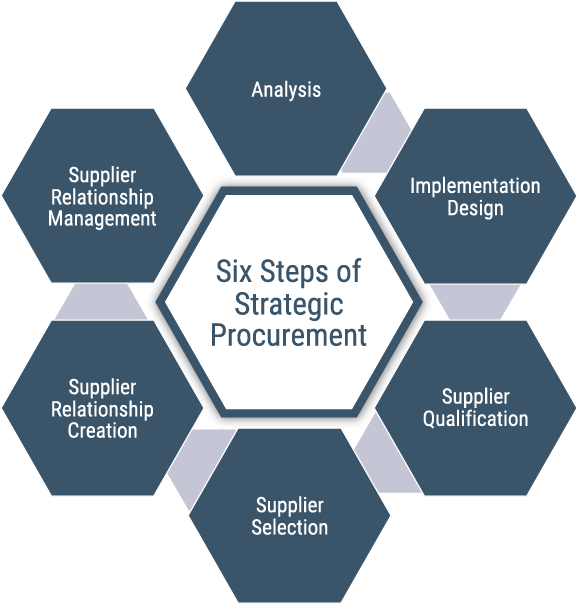The Revitalizing Impact of Strategic Procurement Solutions
As a globally renowned consulting firm specializing in supply chain and operations, SGS Maine Pointe frequently collaborates with clients facing challenges in simultaneous profit growth and expansion efforts.
Recently, in the aftermath of a recapitalization and formal restructuring, a manufacturer of paper products found themselves in a situation where suppliers, stakeholders, and their own employees raised uncertainties about the future direction. SGS Maine Pointe implemented a six-step strategic procurement process to ensure the company would emerge from recapitalization stronger than ever. Success followed and the results included:
- Direct & Indirect Category Savings of 8-to-27%
- EBITDA improvement of 37%
- ROI of 6:1
By focusing on upskilling, harnessing data analytics strategically, and implementing effective procurement processes, the company enhanced visibility into critical data, strengthened relationships, leveraged influence with suppliers, optimized planning, and developed the necessary structure and skills to ensure sustainable results.

Analysis
At the onset of engagement with SGS Maine Pointe, it was clear this manufacturer of paper products lacked visibility into spend. There was uncertainty about where the company allocated its funds, which suppliers were frequently engaged, the specific materials supplied by each vendor, and the individuals responsible for the spending.
Achieving spend control necessitates gaining visibility into expenditures. This begins by establishing consistency across functions, business units, and sites. Key steps include:
- Standardizing spend categories
- Creating uniform specifications
- Ensuring uniformity in supplier agreements
Trustworthy data requires cross-functional collaboration to ensure that information is received from all interested parties, including finance, sales, and operations. With trustworthy data, SGS Maine Pointe developed a digital spend cube for the paper products manufacturer. It gave management its first clear insight into the procurement costs it had to control and the opportunities that existed to save costs across specialty chemicals, commodity chemicals, and fibers.
Implementation design
Reducing costs in a specific area, like procurement of direct materials, can potentially affect other areas. When seeking opportunities for savings, it is essential to:
- Evaluate the impact across sales, finance, procurement, operations, and logistics
- Prioritize these opportunities
- Formulate a strategy for each category.
Achieving that level of insight requires the collaboration of cross-functional teams, coupled with sales, inventory, and operations planning (SIOP) sessions to bring those teams together.
The paper products manufacturer gained from focus and alignment sessions that linked vision, mission, goals, and accountability across functions. Those sessions ensured that everyone was pointed in the same direction. Once silos were penetrated and everyone understood the company’s values and goals, procurement decisions could be made that were in the best interest of the entire company.
Supplier qualification and selection
Supplier conditioning readies suppliers to meet a company's expectations by ensuring they are aware of the standards for quality, cost, delivery, and more. To enhance procurement capabilities, consider:
- Conducting a supplier forum to communicate expectations uniformly, including should cost
- Optimizing supplier selection through optionality and ally sourcing to avoid dependence on a single supplier or country for all supplies
- Engaging in collaborative negotiations with a win-win perspective to achieve industry-leading agreements.
When the paper products manufacturer held its supplier forum, the company not only educated their suppliers, but also improved their own negotiating position. They restored faith that the restructuring was successful and that suppliers would benefit from working with them, giving both parties a competitive advantage. Further, suppliers now understood the company’s short-term and long-term expectations and goals, preparing them to support the company’s growth.
Supplier relationship creation and management
Fostering collaborative supplier relationships is crucial for your company's resilience amidst economic or supply chain challenges. While procurement holds primary responsibility for supplier relations, other functions play integral roles. To enhance these relationships, your company should:
- Continuously monitor spend to ensure alignment with expectations
- Implement supplier scorecards for regular evaluations and feedback
- Address invoicing, specification, and logistics issues promptly.
The paper products manufacturer achieved enduring and mutually beneficial supplier relationships through strategic procurement. SGS Maine Pointe's six-step process, moving beyond transactional procurement, established a solid foundation for financial stability post-restructuring.
This strategic approach simplified the cost structure, improved margins, increased working capital, and facilitated investor exit acceleration. It demonstrated to suppliers, stakeholders, and competitors that the organization had regained control of its future after restructuring and recapitalization.
Results
While numbers provide part of the narrative, the advantages of strategic procurement surpass immediate figures. If your company grapples with silos, lacks spend visibility, and aims to avert future financial crises, adopting a standardized, proven process is imperative.
This six-step strategic procurement process enhances the skill set of your procurement department, ensuring its pivotal role in decision-making. This results in improved spend visibility, motivating suppliers to better align with your cost, quality, and delivery objectives. Establishing this foundation grants you enhanced control over your company's future.
Does your company consider procurement a simple transactional function? A transactional procurement functions is a major lost opportunity to reduce costs, increase working capital, and accelerate the total cost of ownership (TCO) savings. This is especially true when a company’s goal is to bring itself out of financial distress.
